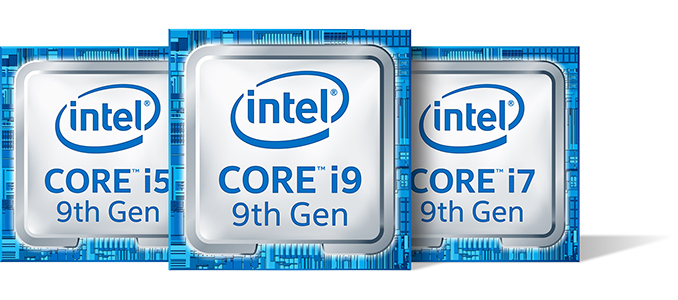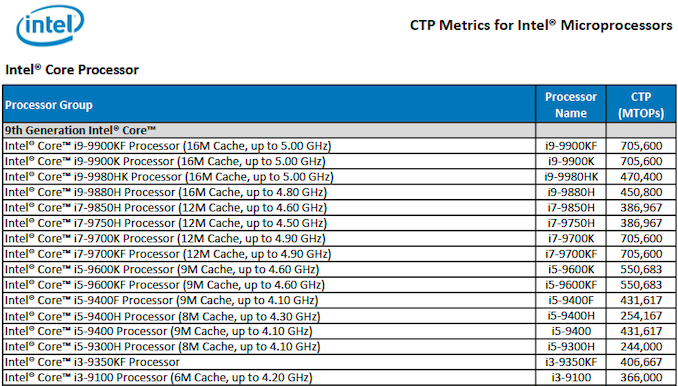Intel Details New 9th Gen CPUs for Notebooks: i9-9980HK to i5-9300H
by Anton Shilov on February 16, 2019 11:00 AM EST- Posted in
- CPUs
- Intel
- Coffee Lake
- Core 9th Gen
- i9-9980HK

Intel is yet has to announce its 9th Gen Core processors for laptops officially, but because the company needs to sort out all the things with authorities and regulators well in advance of actual product launches, CPU model numbers and general specifications have been published well ahead of the formal release. As it turns out, recently the company disclosed the first details about its 9th Gen mobile Core i9, Core i7, and Core i5 H-series processors for higher-end laptops.
Before proceeding to the actual products, let us make it clear what Intel actually revealed. Among other things, Intel (and other companies) has a number of export compliance metrics for its CPUs, including GFLOPS, Adjusted Peak Performance (APP), and Composite Theoretical Performance (CTP). These metrics are used by various governments to determine capabilities of CPUs and other processors. The APP and GFLOPS metrics are used by the US Department of Commerce’s Bureau of Industry and Security (BIS). Meanwhile, other authorities and regulators use CTP calculations, which are stated in Millions of Theoretical Operations Per Second (MTOPS), to assess what companies import to their countries. The CTP numbers are the ones that Intel published for its yet-to-be released CPUs.
The mobile CPUs newly listed are the eight-core Core i9-9980HK processor with unlocked multiplier, the eight-core Core i9-9880H, the eight-core Core i7-9850H, the eight-core Core i7-9750H, the quad-core Core i5-9400H, and the quad-core Core i5-9300H. All of them are aimed at high-performance laptops for gamers and professionals and, according to Intel, will be launched in the second quarter. Since the new processors belong to Intel’s 9th Gen Core family are designed to feature hardware mitigations against specific Meltdown and Spectre vulnerabilities. Meanwhile, a quick look at the basic specs that Intel published as well as their CTP numbers can shed some light on general specifications of the upcoming 9th Gen Core H-series mobile processors.
| Intel 9th Gen Core CPUs for Desktops and High-End Notebooks | |||||||||
| Tier | Model | Application | Cores | Base Freq |
Turbo Freq |
L3 | IGP | IGP Freq |
TDP |
| i9 | i9-9900K | Desktop | 8 / 16 | 3.6 GHz | 5.0 GHz | 16 MB | UHD 630 | 1200 | 95 W |
| i9-9900KF | Desktop | 8 / 16 | 3.6 GHz | - | - | 95 W | |||
| i9-9980HK | Notebook | 8 / 16 | ? | UHD 630 (?) | ? | ? | |||
| i9-9880H | Notebook | 8 / 16 | ? | 4.8 GHz | ? | ? | |||
| i7 | i7-9700K | Desktop | 8 / 8 | 3.6 GHz | 4.9 GHz | 12 MB | UHD 630 | 1200 | 95 W |
| i7-9700KF | Desktop | 8 / 8 | 3.6 GHz | 4.9 GHz | - | - | 95 W | ||
| i7-9850H | Notebook | 8 / 8 | ? | 4.6 GHz | UHD 630 (?) | ? | ? | ||
| i7-9750H | Notebook | 8 / 8 | ? | 4.5 GHz | ? | ? | |||
| i5 | i5-9600K | Desktop | 6 / 6 | 3.7 GHz | 4.6 GHz | 9 MB | UHD 630 | 1150 | 95 W |
| i5-9600KF | Desktop | 6 / 6 | 3.7 GHz | 4.6 GHz | - | - | 95 W | ||
| i5-9400 | Desktop | 6 / 6 | 2.9 GHz | 4.1 GHz | UHD 630 | 1050 | 65 W | ||
| i5-9400F | Desktop | 6 / 6 | 2.9 GHz | 4.1 GHz | - | - | 65 W | ||
| i5-9400H | Notebook | 4 / 8 | ? | 4.3 GHz | 8 MB | UHD 630 (?) | ? | ? | |
| i5-9300H | Notebook | ? | 4.1 GHz | ? | ? | ||||
| i3 | i3-9350KF | Desktop | 4 / 4 | 4.0 GHz | 4.6 GHz | - | - | 91 W | |
| i3-9100 | Desktop | ? | ? | 4.2 GHz | 6 MB | UHD 630 (?) | ? | ? | |
NOTE 1: Keep in mind that Intel has only published very basic specificationsof its upcoming 9th Gen Core CPUs for notebooks (i.e., Turbo frequency and cache size), which is why a number of details published here (e.g., core count, iGPU) are not confirmed officially at this point.
Obviously, the Core i9-9980HK and the Core i9-9980H will sit on top of the range offering eight cores with Hyper-Threading, 16 MB of L3 cache as well as Turbo frequencies close to their desktop counterparts. Meanwhile, the difference between CTP of desktop Core i9 and notebook Core i9 CPUs clearly indicates that their base clocks will be considerably lower, possibly to maintain a 45 W TDP.
Intel’s Core i7-9850H and the Core i7-9750H processors will sit below their Core i9-branded brethren. These chips will feature eight cores (without HT) capable of running at up to 4.6 GHz along with 12 MB of L3 cache. Just like in case of higher-end parts, these CPUs will be clocked considerably lower than their desktop colleagues.
Surprisingly, as far as the cache size and CTP numbers are concerned, the 9th Gen Core i5 H-series processors will not feature six cores, but will pack four Hyper-Threaded cores with 8 MB of L3. While the Core i5-9300H chip will probably run faster than the Core i5-8300H, the Core i5-9400H will have exactly the same base frequency as the Core i5-8400H as they have the same CTP of 254,167 MTOPS.
In addition to mobile CPUs, Intel also disclosed some preliminary details about its entry-level quad-core Core i3-9100 CPU in its document. The chip will run at frequencies of up to 4.2 GHz and will feature 6 MB of L3 cache. Since this is a lower-end part, expect it to be priced accordingly.
As always, Intel does not comment on unreleased products, so take every unconfirmed spec mentioned here with a grain of salt. What we do know for sure at this point is that Intel has finalized specs of its 9th Gen Core H-series processors for laptops and, if everything goes as planned, is on track to launch them in Q2 2019.
NOTE 2: The screenshot of Intel’s document above has been altered in order to better represent the topic of the news story. The original document looks as follows:
Related Reading
- Playing Chicken: Kentucky Fried Intel Core i9-9900KFC Processor Listed
- Intel’s New 9th Gen Desktop CPUs: i3-9350KF, i5-9400F, i5-9400, i5-9600KF, i7-9700KF, i9-9900KF
- The Intel 9th Gen Review: Core i9-9900K, Core i7-9700K and Core i5-9600K Tested
- Analyzing Core i9-9900K Performance with Spectre and Meltdown Hardware Mitigations
- Intel Announces 9th Gen Core CPUs: Core i9-9900K (8-Core), i7-9700K, & i5-9600K
- Intel Coffee Lake Refresh: Global Price Check on 9900K, 9700K, 9600K

















37 Comments
View All Comments
danwat1234 - Saturday, February 16, 2019 - link
8 cores in a 45 watt TDP CPU? That would be impressive! Hopefully that would translate to higher clock speeds with four and six core workloads.. I don't think these processors are any more efficient than coffee Lake.. so it would be interesting what the base clock speed is with 8 cores fully loadedOpencg - Saturday, February 16, 2019 - link
also laptops are typically gimped somehow. usually through cooling, power suppy, both, or bios/embeded controller limits. ive seen 45w cpus throttling hard without ever going past 25w. if you really want performance make sure your laptop can actually supply the power, doesnt have hardcoded bios/embeded controller limits, and has a cooling system up to par. you may have to repaste or undervolt or get a laptop cooler/stand. gud luckshabby - Saturday, February 16, 2019 - link
Most likely cooling is the issue, how can a laptop not supply 45w to its cpu?Anyway an 8 core 45w cpu probably runs at 1.XX ghz with all cores enabled anyway.
yeeeeman - Saturday, February 16, 2019 - link
Not really. A 8750h at 3.9ghz a cores with undervolting is close to the 45w rating, plus or minus. So if a 6 core 12 thread cpu at 3.9ghz is 55w, then in the same 55w you can probably get 3-3.2 GHz 8 core, which is awesome.shabby - Saturday, February 16, 2019 - link
That 8750h is running 6 cores at 2.2ghz base, and i think we all know that intel's tdp is for base clocks not turbo clocks.No one is talking about undervolting here so lets leave that out.
sharath.naik - Sunday, February 17, 2019 - link
Yes, the performance improvement will not be 30% over 6 core. similar to it wasn't 50% for 4->6 cores. Cinebench only scores 1050 for 6 core at 45 watt(limited) this is from 800 for 4 core. Now if your laptop does cool well you can bump the 6 core to 55 watts and get closer to 1200 cine-bench. This is only a ~27% bump for a 50% in cores. so I guess we should assume ~16% bump in performance for a 33% bump in cores for the same wattage. Intel really needs to get to 7 NM on the notebooks first. As AMD is likely going to be releasing a 7nm 8 core notebookchip soon enoughAdrianBc - Saturday, February 16, 2019 - link
No, your clock frequency estimation is too low. Even assuming that Coffee Lake Refresh processors do not have a better efficiency than Coffee Lake processors, the frequency for 8 cores @ 45 W should be around 2.7 GHz or 2.8 GHz for non-AVX programs. For AVX-256 programs the frequency for 8 cores @ 45 W should be at least 2.1 GHz or 2.2 GHz. You should remember that already 4 years ago, in the first variant of the 14 nm process, Intel was making Broadwell processors with 8 cores @ 45 W having a 2.1 GHz base frequency (and 2.6 GHz turbo; this was Xeon D-1541). Now, in the improved process used for Coffee Lake Refresh, the frequencies must be better.shabby - Saturday, February 16, 2019 - link
Don't forget the igpu needs some power too, that xeon you mentioned didn't have an igpu, while these certainly do.AdrianBc - Saturday, February 16, 2019 - link
On Coffee Lake processors, when you are just using a graphic desktop and when using neither a 3D program, e.g. a game, nor a video playing program, which is the normal case when doing a task like the compilation of a software project, the power consumption for the uncore and for the GPU is only around 2 W, so it is negligible. That Xeon has actually a larger power consumption for the uncore, due e.g. to including dual 10 Gb/s Ethernet interfaces.shabby - Saturday, February 16, 2019 - link
I guess i was thinking of a different use case, but i do wonder how much a fully loaded igpu affects the boost clocks.